

Character Classes Or ArchetypesĪs mentioned, the philosophy of Wu Xing plays a major role, as the elements and color-coding are present: In this screenshot, he’s pouncing on hapless soldiers thinking he’s playing Dynasty Warriors. Try to keep each character’s friends close, and their enemies closer as far away as possible. This can lead to tensions and dissatisfaction for both. For instance, if there’s a big red “X” mark for two people in the same city or army, it means they’re not getting along well. Relationships with other characters will also play a role. Satisfaction may increase or decrease because of random events, length of time spent together in the same location or army, the need for higher positions in your government, or character traits. Note: Characters that die in Total War: Three Kingdoms are gone for good.Ĭharacters also have a “satisfaction” mechanic. Legendary characters can suffer more “wounds” before they’re outright killed. The most important factor though would be resiliency. They have slightly better stats, and they may even offer more perks when assigned to positions. If you want to learn more about the themes and characters from this time period, take a look at and the Scholars of Shen Zhou forums.Ĭharacters with a golden nameplate are considered legendary. However, there’s still quite a number of actual historical officers who lived and ruled at the time. Many of these, however, are your generic, non-historical additions. Total War: Three Kingdoms has hundreds of characters in the game. Credit goes to the Total War fandom wiki. They’ll be made playable as an early adopter bonus once the game launches on May 23. They also have a slightly different playstyle. He Yi, Gong Du, and Huang Shao are rebels who are counted as a different subculture compared to the Han officers, and thus they can field different units.

The Yellow Turbans are the last faction type. You already have the Han Emperor under your control and the Han Empire itself as a vassal, allowing you to annex its territories by walking up to settlements and making a payment. The good news is that you have the mighty Lu Bu at your side, and your faction rank is higher, allowing for more armies, administrators, and spies compared to your rivals at the start. The power-hungry demagogue starts at war with almost every other faction. The Tyrant faction leader only has one example: Dong Zhuo. Another key feature is that, at least with Zhang Yan, he can have diplomatic relations with the generic Yellow Turbans faction as well. The difference is that they cannot vassalize the Han. Outlaws such as Zheng Jiang and Zhang Yan have the same progression as Warlords. If you manage to capture a pretender’s capital, that’s when you’ll be able to declare yourself as their equal, establishing your own kingdom.

Their goal, therefore, is to take out all three pretenders to the throne. The difference is that even if governors do become kings, they do not declare themselves as emperors automatically. The same progression for Coalition members still applies for their campaign, including capturing the Han Emperor. Governors such as Ma Teng and Liu Biao are loyal to the Han. To win the campaign, you’ll need to take out the seats of your two rival emperors. Once any faction leader becomes king, they declare themselves emperors, along with the two other leaders that are the strongest. Capturing the city where the Han Emperor resides allows you to vassalize the Han Empire. There are currently five different types of faction leaders in Total War: Three Kingdoms.Ĭoalition members such as Cao Cao and Liu Bei expand their territory to earn prestige. The Middle Kingdom where you battle for supremacy.


 0 kommentar(er)
0 kommentar(er)
